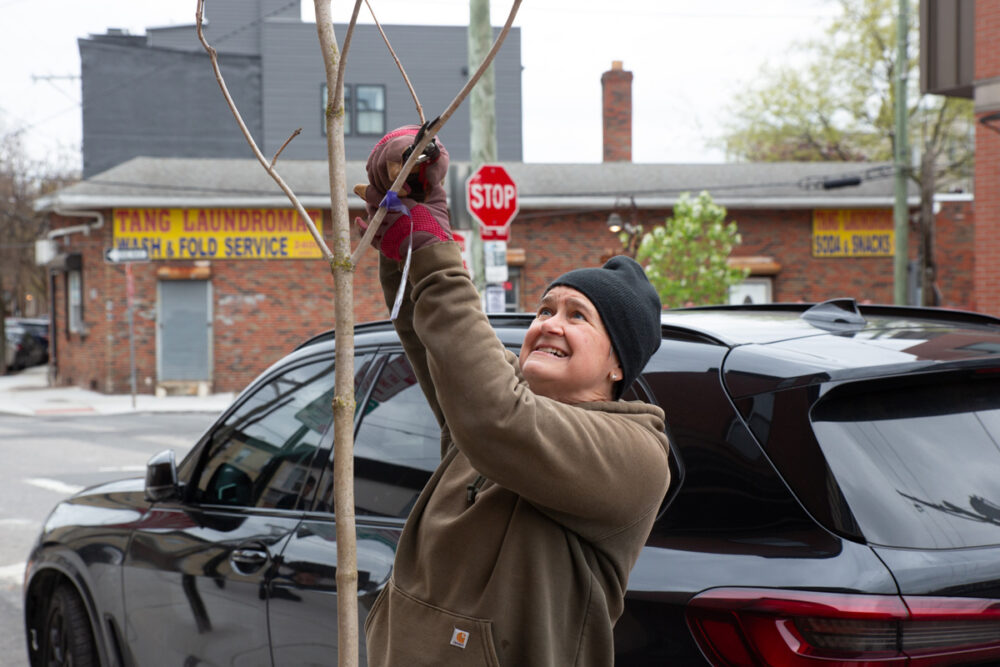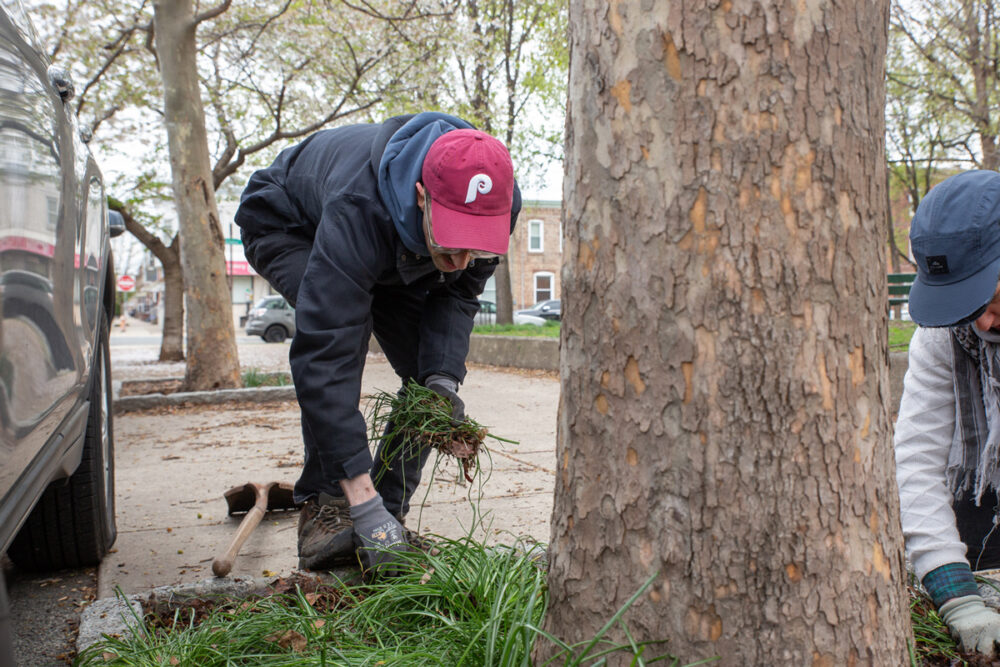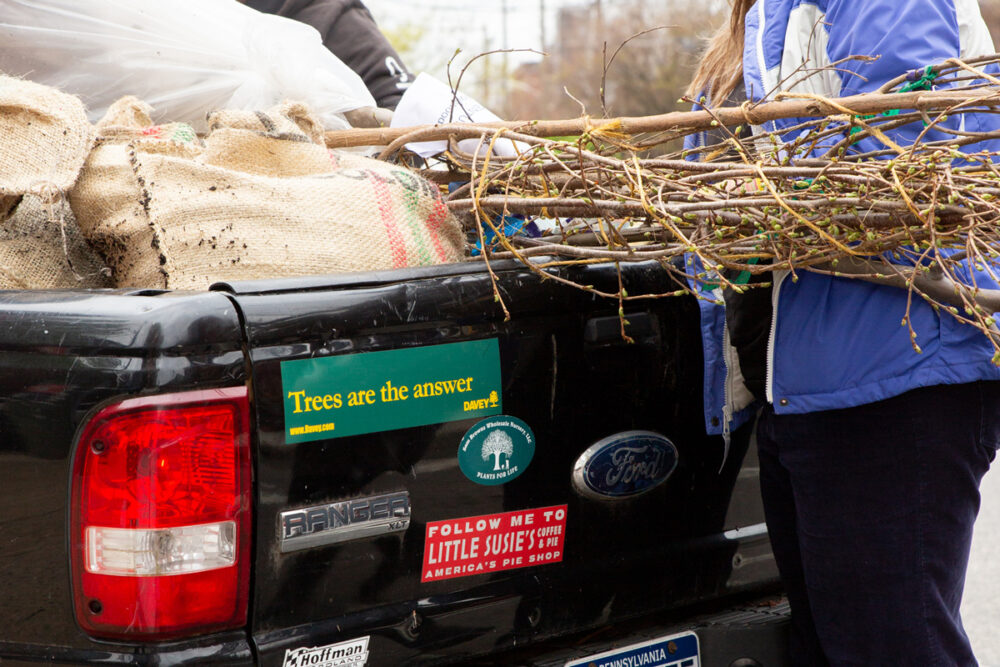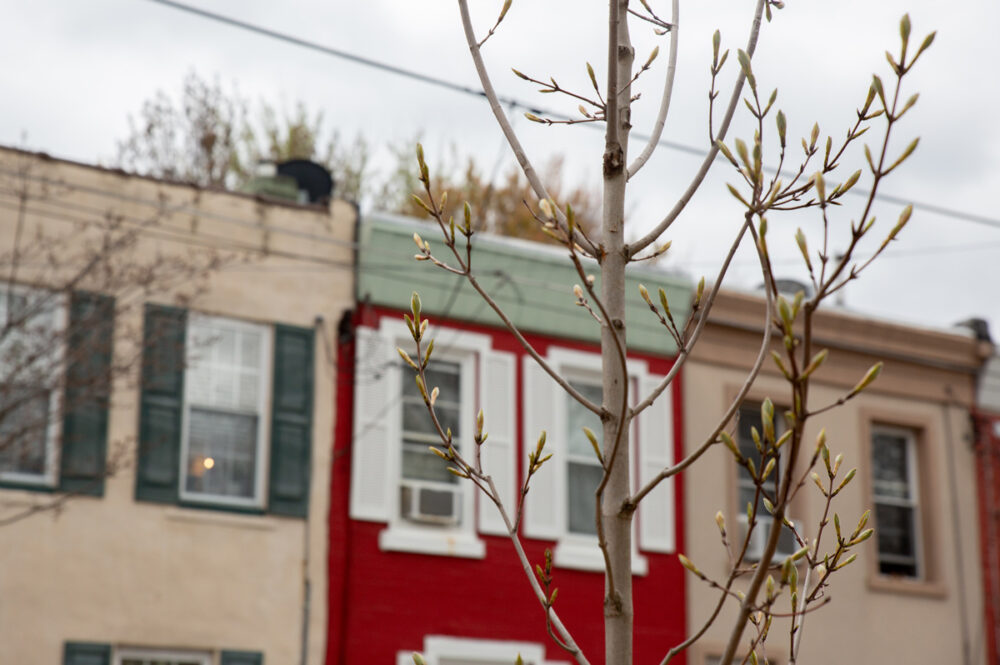
The City’s Tree Plan calls for significantly increasing our leafy coverage. So, why are our large trees continued to be chopped down?
How one neighbor’s loss reflects a citywide dilemma.
“SAVE MY TREE!”
That’s what Nicole Fakhoury heard her two-year-old son crying and begging over the phone, over the sounds of a chainsaw. Fakhoury was at work last January when her babysitter called in a panic.
The tree in question was newly planted in front of Fakhoury’s house when her family bought a home in a new development in Olde Richmond during COVID. As new parents, Fakhoury and her husband loved taking their baby out to see the flowering tree. They hung bird feeders and decorated them for holidays. Fakhoury’s husband diligently watered the tree, and they hired an arborist to help them care for it.
Fakhoury knew not all of their neighbors were having the same success or following up with necessary maintenance, like pruning. Despite the varieties being on a list of appropriate city trees, some believed that the trees were pushing up the sidewalks and causing cracks. They wanted the Homeowners Association to remove the trees. Others, including the Fakhourys, wanted only the damaging trees to be cut down, and pointed out that the trees were included in the deeds to their homes, so were technically their property.

The Fakhourys even hung a sign on their tree, asking that contractors respect their property and not cut down their tree while they worked through things with their HOA.
It didn’t matter. HOA leadership applied for a permit to have all the trees removed – without plans to replace them. The contractor they hired was supposed to get signatures from all of the residents before removing the trees; Fakhoury says they only got two.
“[The contractors] told me, basically, too bad we’re cutting it down with or without your child in the way,” Fakhoury says. “It was pretty traumatic for him.”
Fakhoury isn’t the only resident who has watched in frustration as her favorite tree was cut down. During City Council hearings on the Philly Tree Plan in March, residents were skeptical about the plan to increase tree coverage citywide to 30 percent when the City and other agencies continue to remove trees – especially in large numbers as has happened recently in Cobbs Creek and FDR Park.
Can the City build trust when it’s cutting down trees?

The Tree Plan calls for increasing our tree canopy cover by 30 percent citywide. To do that, some estimates say we need to plant one million total trees over a three-decade period. The plan needs residents to request street trees on residential blocks and yard trees, which can play a critical role in increasing canopy as they often have more space to grow.
“We’re relying on the individuals to apply for a tree because they know the benefits, and then a neighbor who’s been set against it, might see this tree come in and recognize how beautiful it is,” says Jacelyn Blank, an arborist and co-founder of the Tree Tending group Philly Tree People says. “It’s really done on an individual basis.”
The need for resident buy-in means that it’s absolutely critical that residents are engaged both in the education process around trees and understand when they may need to be cut down.
Dr. Hamil Pearsall is a professor of geography, environment and urban studies at Temple. In her research on urban canopies, she’s found that residents are often confused about why trees are being removed, which can make them hesitate to create barriers to planting more trees, especially if they don’t think their city has enough protective tree policies in place. If a developer removes a bunch of trees and there isn’t a plan to replace them, they can become frustrated.
“People commented on the lack of protective tree policies, saying, I noticed, on this particular stretch, that all these trees were removed. Why were they removed? They looked healthy. Why don’t we have better policies for preventing trees from being removed?”
“Other commenters said that when trees were removed, even if they really needed to come down because maybe they became hazardous, there was no plan to replace them.”
Why cut down trees?
Portions of the Tree Plan do call for cutting down trees. In the 1950s, as manufacturing in Philly declined, the city had a lot of vacant land. Residents stepped in to care for a few lots, but others were left unmanaged, and trees spontaneously grew in them, damaging infrastructure. A number of trees, especially the ones in our parks, are mature or overmature, meaning that they’re approaching the end of their lifespan.
“They’re undoing years and years of effort by taking down these trees.”
Anisa George, an arborist and an advocate with Save the Meadows
There are also non-native and invasive species to contend with. Non-native species are trees that aren’t from PA but don’t cause destruction. Still, they’re not great habitats for local pollinators, insects, and birds. Invasives do cause damage. Invasive plants, like choking vines, can kill native trees or limit their growth. Some invasive tree species, like the Callery pear tree, are now banned in Pennsylvania because they’re prone to breaking during storms and crowd out native plants.

Cutting down trees that are damaged, dead or dangerous is also necessary if we want residents to support the idea of planting trees and growing our tree canopy. Neighbors often plant trees together and bond over caring for them. But when people have bad experiences with trees, it’s often because they are damaged or overgrown and have caused damage to people’s homes or cars. Urban trees face a lot of challenges — pollution, having their roots cut because they’re disrupting a sidewalk, and limited soil – which can make it difficult for them to grow. Or, a tree is planted in a space that can interfere with existing infrastructure or buildings.
Still, some of these trees are older and taller, providing valuable canopy cover. This is in part why residents are so upset when the City cuts down large numbers of trees as they have in Cobbs Creek and FDR Park. Last year, the city cut down 441 trees in FDR Park, including 48 heritage trees. There are plans to cut down 300 more, though the PA Department of Environmental Protection (PADEP) recently said there were issues with the City’s application to cut down those trees.
Ra’Chelle Rogers, the communications director for Parks and Rec, says this is a common part of the application process, which the City has factored into their redevelopment timeline. She says this does not mean the City’s application has been declined and that Parks and Rec and the Fairmount Park Conservancy have provided answers to PADEP so that the review can move forward. Rogers says the City plans to plant nearly 14,000 native trees to compensate for the ones that will be cut down.
Those trees, though, will take years to grow big enough to provide the same coverage and delight to residents.
“In a space like FDR Park, you have 80-year-old trees that are healthy and doing well. You’re almost never going to see a street tree get to that point,” says Anisa George, an arborist and an advocate with Save the Meadows, a group that has been advocating for protecting the woodlands in FDR Park. George came to really appreciate FDR’s meadows during the pandemic when she spent a lot of time in the rewilded space. “They’re undoing years and years of effort by taking down these trees.”
New plantings, of course, should prioritize native species, George says, but if a non-native tree has grown large, we need to balance supporting our local ecology with our goals of increasing tree canopy and reducing the amount of carbon we emit. Generally, arborists leave large, non-native trees that are thriving alone and don’t cut them down, but remove invasives because they can be damaging — that helps strike a balance.

“I think we need to change the conversation around non-native trees,” she says. “If a tree is succeeding in an urban environment, let it be.”
Communicating with residents
Cutting down trees threatens Philly’s ability to grow its tree canopy. The larger older trees provide more shade and capture more carbon quicker. It takes a number of years for young trees to have an impact on the canopy and when residents see trees being cut down, it can cause them to disengage from the plan.
Some volunteer tree planters in the city are actively working on tree succession planning, planting young trees so they have time to grow before an older tree reaches the end of its lifespan. Dominique London, executive director of the nonprofit, Tree Tending Group UC Green, points to young trees growing alongside old ones in Malcolm X Park as examples of this work. Planting young trees before older ones reach the ends of their life will be especially important in the City’s natural lands, which make up 34 percent of the current tree canopy.
When it comes to street trees, Erica Smith Fichman, Philadelphia Parks and Rec’s city forester, says the City is now being proactive about communicating with residents when their trees are removed.
“When we go to remove street trees, we send a letter to every resident who’s getting their tree removed to inform them and then to give them the opportunity to communicate with us about that,” she says.
That’s a good step, though it doesn’t always guarantee HOAs or other groups will respect their residents’ wishes, as happened with Fakhoury.
“If I had been in that position or been able to delegate, I would have been like, okay, can we figure out a way to not remove the trees, but fix the sidewalks. Can we remove some to deal with the heaving?” Blank says. She was speaking with neighbors about the removal at the time.“But that wasn’t the case.”
More than a year and new HOA president later, Fakhoury is on the way to getting a new tree. The new HOA president is working with Philly Tree People, their tree tending group, to replace the trees that were cut down.
“He has taken it upon himself to really communicate with [Philly Tree People] and the City and make sure that we get trees that are good for the street and houses and the soil and the environment,” she says.

This article is published in collaboration with the Philadelphia Citizen as part of a project series for the Philadelphia Journalism Collaborative.





